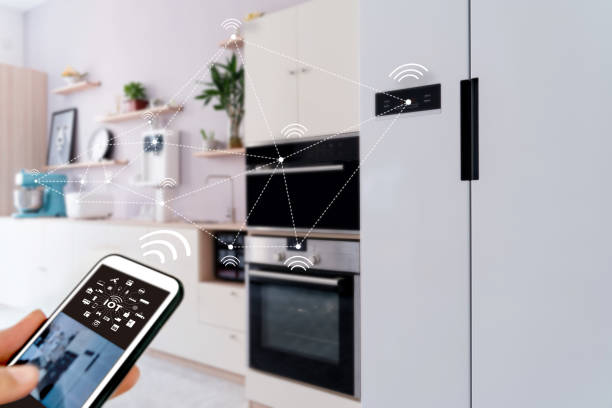Imagine walking into your home after a long day at work, and your house knows exactly how to welcome you. The lights dim to your preferred setting, the thermostat adjusts to your favorite temperature, and your smart speaker plays your go-to relaxation playlist.
Welcome
to the world of smart homes in 2024, where cutting-edge technologies are
transforming our living spaces into personalized, efficient, and secure
environments. Let's explore the latest trends shaping the future of home
automation.
1. Integration of AI and Machine
Learning
Artificial
intelligence (AI) and machine learning are not just buzzwords anymore; they are
the backbone of modern smart home systems. These technologies enable devices to
learn your preferences and habits, offering a highly personalized experience.
Imagine your coffee machine brewing just as you wake up, or your lights dimming
automatically when you settle in to watch a movie. AI optimizes energy usage by
predicting when you're home or away, adjusting lighting and heating
accordingly.
A
smart thermostat like the Nest Learning Thermostat learns your schedule and
temperature preferences, adjusting settings to save energy and ensure comfort.
By analyzing data from motion sensors and your usage patterns, it can
automatically switch to an energy-saving mode when you leave home.
2. Voice Control and Natural Language
Processing
Voice
assistants like Amazon Alexa, Google Assistant, and Apple Siri are becoming
smarter and more intuitive. Natural language processing advancements allow
these systems to understand and respond to more complex commands, making
interaction seamless and more enjoyable.
Did
you know you can ask Alexa to tell you a joke? It's a great way to add a little
humor to your day while interacting with your smart home.
3. Enhanced Security Features
Home
security is a major focus in smart home technology. Innovations include
advanced facial recognition systems, smart locks with biometric authentication,
and AI-powered surveillance cameras that can detect unusual activity and alert
homeowners in real-time. These features provide peace of mind and enhance the
safety of your home.
Ring's
AI-powered video doorbells can recognize familiar faces and send alerts when a
stranger is at your door. Paired with a smart lock, you can remotely unlock
your door for trusted visitors or delivery personnel.
4. Energy Management Systems
Smart
energy management systems are becoming more sophisticated, integrating with
renewable energy sources like solar panels. These systems manage energy
storage, usage, and even sell excess energy back to the grid. They promote
sustainability and can significantly reduce your utility bills.
Tesla's
Powerwall is a popular home battery that stores energy from solar panels and
provides backup power during outages. It's a step towards a more sustainable
and resilient energy system.
5. Interoperability and Ecosystem
Expansion
One
of the biggest challenges in smart home adoption has been the lack of
interoperability between different devices and brands. In 2024, there is a
significant push towards creating more unified ecosystems, where devices from
various manufacturers can seamlessly communicate and work together. This makes
it easier for users to integrate and manage their smart home devices.
The
Matter standard, supported by major tech companies, aims to ensure that smart
home devices are compatible across different brands and platforms. This
initiative is set to make smart home setup and management more straightforward
for consumers.
6. Health and Wellness Monitoring
Smart
homes are increasingly focusing on health and wellness, integrating devices
that monitor air quality, detect allergens, and even track sleep patterns.
Smart beds, air purifiers, and connected fitness equipment are becoming
standard features in modern smart homes, helping residents maintain a healthier
lifestyle.
The
Withings Sleep Analyzer can monitor your sleep cycles, detect snoring, and even
assess sleep apnea. It provides insights and tips to improve your sleep
quality, contributing to better overall health.
7. 5G Connectivity
The
rollout of 5G technology is enhancing the capabilities of smart homes by
providing faster, more reliable internet connections. This improves the
performance of smart devices, enabling real-time data processing and seamless
streaming for entertainment systems. With 5G, lag and buffering are becoming things
of the past.
Imagine
streaming 8K video content or hosting a virtual reality game night without any
lag. 5G connectivity makes this possible, transforming your home entertainment
experience.
8. Sustainable and Eco-Friendly Smart
Devices
Sustainability
is a growing concern, and smart home manufacturers are responding by developing
eco-friendly products. This includes energy-efficient appliances, smart
irrigation systems for water conservation, and devices made from sustainable
materials. These innovations not only reduce your environmental footprint but
also lower utility costs.
Did
you know that smart faucets can reduce water usage by automatically adjusting
flow based on the task at hand? It's a small change that makes a big difference
in water conservation.
9. Advanced Home Entertainment Systems
Smart
homes are revolutionizing home entertainment with high-tech audio and video
systems that offer immersive experiences. Innovations include 8K TVs, advanced
sound systems, and virtual reality setups that provide cinema-quality
entertainment at home. These systems are designed to create an unparalleled viewing
and listening experience.
The Samsung QLED 8K TV offers stunning picture quality with AI upscaling, making even standard content look amazing. Paired with a Dolby Atmos sound system, it turns your living room into a home theater.
The
smart home landscape is rapidly evolving, with 2024 bringing significant
advancements in AI, security, energy management, and interoperability. These
trends not only enhance convenience and comfort but also promote sustainability
and improved quality of life.
Whether
you're a tech enthusiast or just looking to make your home a bit smarter,
there's never been a better time to explore the latest in home automation.













Comments
Post a Comment